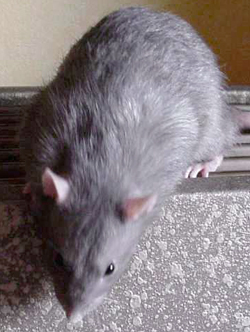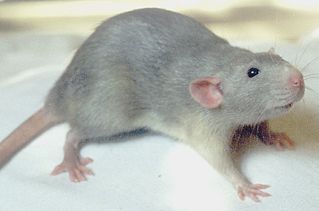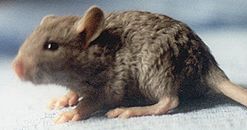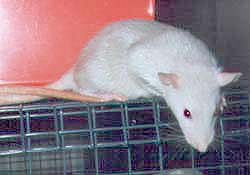Blue
Also known
as: Standard Blue, English Blue, Powder Blue,
Sky Blue, American Blue, Australian Blue, Slate
Blue.
Origins Twelve years later, the Blue rats
seen at shows in the UK are an unusual, intense shade of blue (as
in artist's or paint colour), with a tint quite unlike the Blue
varieties of other animals which are commonly more of a slate grey
shade. Darker blue rats sometimes have a violet hue, while paler
shades of the colour can appear to have a slightly greenish or turquoise
hue noticeable on the flanks and sides.
In the
USA, the origin of the Blue rat is less
certain. Its exact history has not been recorded,
though the AFRMA claim it was "found in a pet shop
in 1990". The puzzling similarity of story to the
English discovery has not prevented the AFRMA from
insisting it was an American pet shop, in the same
year.
Stranger things
have happened and it is not unknown for identical
mutations to occur in separate parts of the world,
but while the AFRMA has no record of importing Blue
rats from England, the NFRS did export blue rats to
the USA in the early 1990's. There are,
additionally, American breeders not associated with
AFRMA, who have made imports of British blues. With
no definitive record of the Blue rat's first
appearance in America, set against the
well-documented account of its appearance in the UK
and records of transatlantic export, British
breeders feel sure that the Blue gene originated in
England. This would go a long way to explain the
genetic compatibility discussed below.
BLUE
RAT FROM ENGLAND, Australia
announced the discovery of a Blue gene in 2001,
currently under development by breeders there.
Descriptions and photographs strongly suggest that
it is a similar gene to Blue known in the rest of
the world, with the same tendency to whitish/light
undercolour, and variation in shade from light to
dark. In the words of one breeder, the colour is
"vibrant, bright blue" with black eyes. The first
Blue Agoutis in Australia were born in early 2002.
As all imports of fancy mice and rats into
Australia are strictly prohibited, it is assumed
this is a remutation of the Blue gene known
elsewhere.
Blue
Standards
UK A lighter shade
of blue is occasionally seen in the UK, and was
bred in the early days as Powder
Blue.These are less common nowadays and
are classed as an Unstandardised variety.
Europe The shade of
American blues in Europe is comparable to the UK's
Powder Blue, and most have a great deal of white in
the undercoat. It is in this variety that the
yellow tint is most noticeable.
USA The AFRMA
recognises Blue, a slate blue colour, as
dark as possible, and Sky Blue, a clear
glittering blue in between Blue and Slate Blue.
Powder Blue, though mentioned in the Sky
Blue standard, does not appear to be
standardised.
The RMFE
also standardises three shades, all with black
eyes. American Blue aka Slate Blue is
a medium shade which may have a white undercolour;
Powder Blue, very pale blue, and Sky
Blue, which is between the
two.
AMERICAN
BLUE DUMBO, FROM Genetics
of the Blue
Matings between
American Blues and English Blues suggest that all
shades of Blue [except Russian:
see below] are produced by the same gene.
Breeders in Holland, Belgium and England combining
American lines with dark English blue rats have so
far all produced blue offspring. Further
investigation is taking place but it would not be
unreasonable to conclude that the gene is the same.
Nichole Royer, writing in the Summer 1999 issue of
the AFRMA journal states: "Blue, English Blue,
Slate Blue, American Blue and Sky Blue are
genetically all the same thing."
There is some
confusion over the genetic symbol used for Blue in
different countries. In the USA and Europe,
American Blue is given the designation g
(Grey) but this has not been scientifically
described.
In the UK the
eminent animal geneticist Roy Robinson, author of
many books including "Genetics for Cat Breeders"
took a keen interest in the discovery of the Blue
rat. Roy was a lifelong rat enthusiast, owner and
breeder, and was responsible for introducing the
Rex and Siamese genes to the rat world in the
1970's.
He took some of
the first Blues to breed them himself, and
considered them to be a re-appearance of the
previously recorded Blue gene, symbol d
(Dilution), absent from the gene pool for many
years. As a result, his designation of d has
been used in the UK for this colour since the early
1990's. Rediscoveries of previously recorded genes
are not re-described in genetics journals, so Roy
did not write a paper about the Blue rat, although
he referred to it as d in his articles
published in the NFRS newsletter and in at least
one published scientific work.
The lighter Powder Blue shade
has been suggested by some to be the effect of a modifying gene,
possibly the same one which lightens Mink to American Lilac. However,
there may be more than one modifier which lightens the colour. A
mating between a Platinum with American ancestry to a Powder Blue
from English lines unexpectedly produced offspring of the dark shade
favoured at shows in the UK.
Another possibility is that the
light and dark shades may be different alleles of the same locus.
If this theory is correct, it would be hard to say at present which
might be the more dominant of the two, though it may turn out to
be the darker shade. The few breeders who have been able to cross
the colours so far report a variation of shade in the litters, but
there are usually a few dark ones.
Certainly, if the
dark shade was dominant, or incompletely dominant,
it would explain why some lines of American Blues
never produce dark rats, whereas many dark blue
lines in the UK occasionally throw lighter blues.
Nichole Royer also confirms that Powder Blues are
occasionally produced in litters of dark blues in
the USA. UK breeder Ann Storey, who has bred Blues
from the very early days, observes that two light
blues bred together never seem to produce a dark
one. This could be one reason why, in certain areas
and countries, the lighter blue is the more common
shade.
However, presence
or absence of a modifier could easily produce
similar results, as could a subtle influence by
other genes carried. It should be remembered too,
that the first English Blues were much lighter than
we know today, and would probably fall into the the
Sky Blue category at American shows.
Note: The genetics information
given in this article represents work in progress and may change over time.
Last updated December 1st. 2002.

First reported in England in the summer of 1990,
when Joan Branton, a member of the NFRS, discovered
three mismarked Hooded kittens in a pet shop which
were a clear bright blue, a colour never seen
before by rat fanciers in the UK.

BRED
BY SHEILA SOWTER,
CLEARLY
SHOWING THE
INTENSE
BLUE
COLOUR AND TINT.
OWNER:
CARINE VEREECKE,
RATTERY
ZONIEN, BELGIUM.
In the UK the
NFRS standard for Blue (used by all
British rat clubs) calls for a dark shade of steel
blue without white undercoat. Breeders have managed
to achieve this through selection, and kept the
white undercolour to a minimum. Non-show quality
blues are frequently lighter in shade, and may have
varying amounts of white undercolour.
In the
Netherlands and Belgium, where most Blue rats are
descended from lines imported from the USA, blues
are a much lighter shade than in the UK. Clubs in
these countries classify the light blue as
American Blue and the less common dark blue,
imported from England, English Blue.
Blue rats are
standardised by all the major USA clubs:
The RMCA classifies two shades: Blue,
also called Slate Blue,which is required
to be as dark as possible, with dark ruby or black
eyes, and Powder blue,a medium shade,
lighter than slate blue, with ruby or dark ruby
eyes.

AMERICAN
LINES, BRED IN THE
UK
BY
LUCIE MANN. NOTE THE
YELLOW
TINT
ON THE FLANKS.
The Russian Blue, a
different gene entirely, is referred to as d (Dilution) in
the USA. This colour first appeared in 1993, but was unknown in
the UK until 2000, so Roy Robinson did not have the chance to see
a Russian before his death in 1996. This was an enormous pity, since
he would have been very interested in the variety and would surely
have been able to classify it scientifically. In the absence of
his guidance, and to avoid confusion with the UK's established usage
of d for the English Blue, Russian is designated rb
by British breeders working with the colour. Russian Blue is discussed
in more detail here.

RUSSIAN
BLUE REX KITTEN

ENGLISH
POWDER BLUE
FROM
ENGLISH LINES,
BRED
AND OWNED BY
ESTELLE
SANDFORD
BLUE
Dark intensely
blue shade preferred for shows. Black eyes.
UK (all
clubs) Recessive
gene. POWDER
BLUE
Palest blue.
Black eyes.
UK
(Unstandardised) May be a lighter
shade of blue or result of additional
modifier.
SLATE
BLUE
As Blue.
USA (RMFE)
As Blue.
SKY
BLUE
Medium bright
blue shade. Black eyes.
USA (AFRMA,
RMFE)
As Blue.
ENGLISH
BLUE
As Blue.
USA, HOLLAND,
BELGIUM, GERMANY
As Blue.
AMERICAN
BLUE
Used variously to
describe lighter and medium shades. Black
eyes.
USA, HOLLAND,
BELGIUM As Blue.
AUSTRALIAN
BLUE
Light and medium
shades. Black eyes.
AUSTRALIA Believed to be
same gene as Blue.
RUSSIAN
BLUE
Dark greyish blue
similar to blue dogs, cats & mice. Black
eyes.
Used in all clubs
worldwide.
Recessive gene
not related to other Blue.
USA (RMCA,
AFRMA)
UK dd
Scientific
designation
USA gg
amateur usage
Europe gg
amateur usage
USA (RMCA,
AFRMA)
UK
(unstandardised shades between Powder and standard
Blue).
Recently discovered.
UK rbrb
amateur usage
USA dd
amateur usage
Europe dd
amateur usage
SourcesPro-Rat-A #63, May/June 1991 "Birth of the Blues" by Joan Branton
Pro-Rat-A #73, Jan/Feb 1993 "The Silver Blue" by Roy Robinson
Personal correspondence, Ann Storey, NFRS
Personal correspondence, Karen Robbins, AFRMA
Personal correspondence, Tracey York, bRatpack Rattery, Australia
AFRMA Newsletter Vol.16 No.3 "Russian Blue Rats" by Nichole Royer
AFRMA Newsletter Vol.16 No.3 "Colours & Coats" by Nichole Royer
Genetics section, http://www.rodentfancy.com (Myomorpha)
RMFE website, http://www.rodentfancy.com
AFRMA website, http://www.afrma.org
RMCA website, http://www.rmca.orgOther Contributors
Marion Benham, Chris Casteels, Lucie Mann, Estelle Sandford, Carine Vereecke.
ALL PARTS OF THIS ARTICLE INCLUDING TEXT AND IMAGES STRICT COPYRIGHT © SUE BROWN 2001/2002
NO PART OF THIS ARTICLE MAY BE COPIED OR REPRODUCED WITHOUT PRIOR PERMISSION OF THE AUTHOR.
ALL RIGHTS RESERVED.